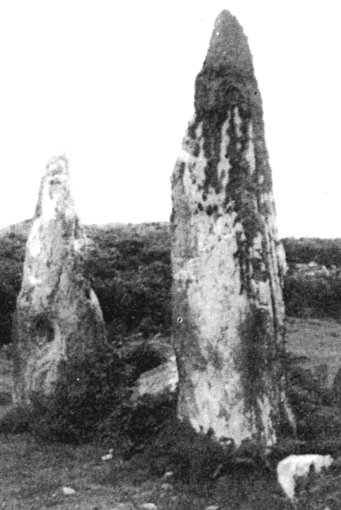By Michael Hannon
Stones seem to have a strange fascination for very many people. I suppose the reason may be that we are ever curious to find out something of our past, and strangely enough the past has an irresistible attraction for us all.
A stone which intrigued me during my school-days was one known locally as St. Patrick’s Stone. This stone had an indentation in it which, tradition had it, was made by the Saint placing his knee on it. I spent many a pleasant Sunday there playing in the field where the stone lay with friends of mine. Nearby was an old ruin where it is believed St. Patrick built a church. In the same field also was a children’s burial ground where the unbaptised infants were laid to rest.
To us in this day and age it seems strange that children should be set apart; not fit, as it were, to be interred in consecrated ground. This stone which we called St. Patrick’s stone, is also known as a Bullaun stone. It may have been used for the purpose of crushing grain in times gone by. I myself would rather cling to the belief that the great Saint himself knelt on it.
Now another stone called an Ogham stone can be found in many parts of Ireland. It gets its name from Ogham who was the old Celtic God of writing. Ogham is an ancient form of script, each stroke of which is related to a letter in the Latin Alphabet.
However, it has also been established that Ogham Stones are also bilingual. The first Ogham Stone to be found giving script in both Gaelic and Latin was the one found near Nevern in Pembroke in 1906. It was this stone which provided scholars with the key to decipher the Ogham Alphabet. It can be seen today in the church of St. Brynach in Nevern.
It may seem strange as to why an Ogham stone containing Gaelic could be found in Wales, but then on deeper study, it’s not that strange at all. The Irish raiders from way back made incursions into Wales, from as early as the second century in fact. All along the peninsula of Gwynedd, west of Caernafon, there settled for a time an Irish tribe known as Laigen, otherwise the Spearmen. Most probably it’s from this tribe that the province of Leinster derives its name.
There are different forms of stones in many parts of Ireland including Bullaun stones, Ogham stones, and some known as Gaullan stones. Gaullan stones, in the main, stand around twelve feet high. These stones have no markings on them. There are others of course which have spirals and whirls, the meaning of which is lost in the mists of time.
It cannot be said with any degree of certainty, the purpose for which many of these stones were erected. No doubt some of these stones were ritual or sacred stones where some sect or tribe carried out their rituals. It could be that stones themselves were objects of worship.

One of Galway’s most well-known stone is the Turoe stone, near Loughrea. This stone has circular and zig-zag marking. It is believed that the Turoe stone by virtue of its shape and size was hewn by hand and the markings on it carved by hand. Near Fuerty, in Co. Roscommon, there is an Iron Age boulder known as the Castlestrange stone. This egg-shaped rock has spirals and Whorls similar to those shown on the Turoe stone. The Castlestrange stone would appear to be of natural rock formation.
Two stones which can be found standing side-by-side are to be seen on the Island of Cape Clear off the Cork coast. One is known as “A Marriage Stone”. It has a hole in the lower part through which couples who have pledged themselves to each other can touch hands. Of all the stones however, the Ogham stone is perhaps the most interesting.
Perhaps the most interesting one is the one in St. Flannan’s Cathedral, Killaloe, Co. Clare. It has a bi-lingual inscription in Irish Ogham and Scandinavian script called rune. The runic script reads “Thorgrim carved this cross”. The Ogham script reads “A Blessing upon Thorgrim”. This stone was found in 1916 by a Professor MacAlister. “Thorgrim” was a Viking responsible for the destruction of monasteries and churches who in time became a convert to the Christian faith.
All we can say about stones is that they hold secrets which will ever remain silent as the stones themselves.

